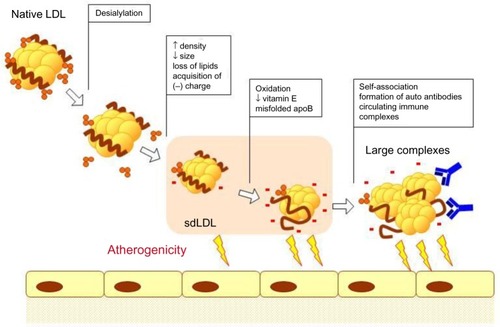Figures & data
Figure 1 Atherogenic modifications of LDL.
Notes: Multiple atherogenic modifications of LDL particles have been detected in human blood plasma: desialylation was the first event, followed by loss of free cholesterol and cholesterol esters, phospholipids and triglycerides, increase of particle density, and decrease of its size; next, negative charge of particles was increased, leading to the formation of electronegative LDL fraction, in which misfolded apoB was reported; at later stages, increased oxidation and decreased antioxidant content were observed; finally, large, highly atherogenic complexes were formed due to self-association of modified LDL particles and the formation of autoantibodies.
Abbreviations: LDL, low-density lipoprotein; sdLDL, small dense LDL.
Abbreviations: LDL, low-density lipoprotein; sdLDL, small dense LDL.

Figure 2 Atherogenic properties of electronegative LDL.
Notes: Several features account for the increased atherogenicity of electronegative LDL [LDL(–)]: formation of autoantibodies and susceptibility to self-association lead to formation of complexes with high atherogenicity. LDL(–) can cause endothelial dysfunction through interaction with LOX-1 receptors. Interaction of LDL(–) with proteoglycans in the subendothelial intima causes increased retention of the particles that serve as a source of lipid storage.
Abbreviations: LDL(–), electronegative low-density lipoprotein; LOX-1, LDL receptor 1.
Abbreviations: LDL(–), electronegative low-density lipoprotein; LOX-1, LDL receptor 1.

